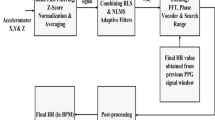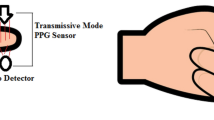Abstract
The importance of monitoring vital signs is increasing with the increase in the number of elderly people and deaths from chronic diseases worldwide. Various studies have been conducted for vital sign monitoring, and it has been confirmed that the transmit time, gradient, and amplitude of pulse signals are highly correlated with blood pressure (BP) and respiration rate (RR). In this study, a single photoplethysmography (PPG) sensor-based wearable device is designed for the continuous monitoring of BP, RR, and heart rate (HR). The device is designed as an earphone type for fixedness and signal stability; it transmits data via an Arduino-based Bluetooth module for wireless use and supplies power via batteries. Because of the similar frequency range between pulse signals and walking signals, denoising is difficult to perform via frequency analysis, where the noise of the PPG signal is isolated via denoising long short-term memory (LSTM) auto encoder. The gradient element, HR, and envelope are extracted as features from the denoised PPG signal, and BP regression models and RR measurement algorithms are designed based on these features. Finally, the reference vital signs and signals measured by the device are compared to verify the accuracy of the device. Results show that the average errors for diastolic blood pressure (DBP), systolic blood pressure (SBP) and RR are 3.93%, 6.38%, and 8.95%, respectively.















Similar content being viewed by others
References
Addison PS (2016) Slope transit time (STT): A pulse transit time proxy requiring only a single signal fiducial point. IEEE Trans Biomed Eng 63(11):2441–2444
Allen J (2007) Photoplethysmography and its application in clinical physiological measurement. Physiol Meas 28(3):R1
Anderson E, Durstine JL (2019) Physical activity, exercise, and chronic diseases: a brief review. Sports Med Health Sci 1(1):3–10
Arsene CT, Hankins R, Yin H (2019) Deep learning models for denoising ECG signals. In: 2019 27th European signal processing conference (EUSIPCO), IEEE (pp 1–5)
Atella V, Piano Mortari A, Kopinska J, Belotti F, Lapi F, Cricelli C, Fontana L (2019) Trends in age-related disease burden and healthcare utilization. Aging Cell 18(1):e2861
Budidha K, Kyriacou PA (2018) In vivo investigation of ear canal pulse oximetry during hypothermia. J Clin Monit Comput 32(1):97–107
Chandrasekhar A, Kim CS, Naji M, Natarajan K, Hahn JO, Mukkamala R (2018) Smartphone-based blood pressure monitoring via the oscillometric finger-pressing method. Sci Transl Med 10:431
Corbishley P, Rodriguez-Villegas E (2007) Breathing detection: towards a miniaturized, wearable, battery-operated monitoring system. IEEE Trans Biomed Eng 55(1):196–204
Da He D, Winokur ES, Sodini CG (2015) An ear-worn vital signs monitor. IEEE Trans Biomed Eng 62(11):2547–2552
Elgendi M (2012) On the analysis of fingertip photoplethysmogram signals. Curr Cardiol Rev 8(1):14–25
Folke M, Granstedt F, Hök B, Scheer H (2002) Comparative provocation test of respiratory monitoring methods. J Clin Monit Comput 17(2):97–103
Ji T, Pachi A (2005) Frequency and velocity of people walking. Struct Engineer 84(3):36–40
Jose AD, Collison D (1970) The normal range and determinants of the intrinsic heart rate in man. Cardiovasc Res 4(2):160–167
Laitala J, Jiang M, Syrjälä E, Naeini EK, Airola A, Rahmani AM, Liljeberg P et al (2020) Robust ECG R-peak detection using LSTM. In: Proceedings of the 35th annual ACM symposium on applied computing (pp 1104–1111)
Lee J, Sun S, Yang SM, Sohn JJ, Park J, Lee S, Kim HC (2018) Bidirectional recurrent auto-encoder for photoplethysmogram denoising. IEEE J Biomed Health Inform 23(6):2375–2385
Leite NMN, Pereira ET, Gurjão EC, Veloso LR (2018) Deep convolutional autoencoder for eeg noise filtering. In: 2018 IEEE international conference on bioinformatics and biomedicine (BIBM), IEEE (pp 2605–2612)
Lockwood C, Conroy-Hiller T, Page T (2004) Vital signs. JBI Rep 2(6):207–230
Moneta LB, Quintanilla-Dieck L (2017) Embryology and anatomy of the ear. Oper Tech Otolaryngol Head Neck Surg 28(2):66–71
Mukkamala R, Hahn JO, Inan OT, Mestha LK, Kim CS, Töreyin H, Kyal S (2015) Toward ubiquitous blood pressure monitoring via pulse transit time: theory and practice. IEEE Trans Biomed Eng 62(8):1879–1901
Nepal K, Biegeleisen E, Ning T (2002) Apnea detection and respiration rate estimation through parametric modelling. In: Proceedings of the IEEE 28th annual northeast bioengineering conference (IEEE Cat. No. 02CH37342), IEEE, (pp 277–278)
Olivares DE, Chambi FR, Chañi EM, Craig WJ, Pacheco SO, Pacheco FJ (2017) Risk factors for chronic diseases and multimorbidity in a primary care context of central Argentina: a web-based interactive and cross-sectional study. Int J Environ Res Public Health 14(3):251
Poon CCY, Zhang YT (2006) Cuff-less and noninvasive measurements of arterial blood pressure by pulse transit time. In: 2005 IEEE engineering in medicine and biology 27th annual conference, IEEE (pp 5877–5880)
Shrestha A, Mahmood A (2019) Review of deep learning algorithms and architectures. IEEE Access 7:53040–53065
Siam AI, Abd-El-Samie F, Abu Elazm A, El-Bahnasawy N, Elbanby G (2019) Real-world PPG dataset. Mendeley Data 2019:68
Sun Y, Dong Y, Gao R, Chu Y, Zhang M, Qian X, Wang X (2018) Wearable pulse wave monitoring system based on MEMS sensors. Micromachines 9(2):90
Tamura T (2019) Current progress of photoplethysmography and SPO 2 for health monitoring. Biomed Eng Lett 9(1):21–36
Vincent P, Larochelle H, Bengio Y, Manzagol PA (2008) Extracting and composing robust features with denoising autoencoders. In: Proceedings of the 25th international conference on machine learning (pp 1096–1103)
Wertheim D, Olden C, Savage E, Seddon P (2009) Extracting respiratory data from pulse oximeter plethysmogram traces in newborn infants. Arch Dis Child Fetal Neonatal Ed 94(4):F301–F303
World Health Organization (2017) Global strategy and action plan on ageing and health
Acknowledgements
This work was supported by the National Research Foundation of Korea(NRF) grant funded by the Korea government (MSIT) (2021R1A2C2013053) and Gachon University research fund of 2021 (GCU-202103840001).
Author information
Authors and Affiliations
Corresponding author
Additional information
Publisher's Note
Springer Nature remains neutral with regard to jurisdictional claims in published maps and institutional affiliations.
Rights and permissions
About this article
Cite this article
Park, SH., Choi, SJ. & Park, KS. Advance continuous monitoring of blood pressure and respiration rate using denoising auto encoder and LSTM. Microsyst Technol 28, 2181–2190 (2022). https://doi.org/10.1007/s00542-022-05249-0
Received:
Accepted:
Published:
Issue Date:
DOI: https://doi.org/10.1007/s00542-022-05249-0




